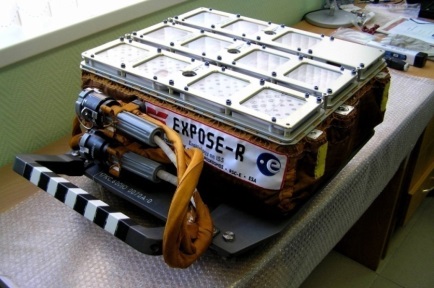EXPOSE
EXPOSE is a facility dedicated to exobiology, developed by ESA for medium- and long-term flights and installed outside the International Space Station (ISS) (Figure 1). It is designed to enable several simultaneous experiments involving the exposure of chemical and biological samples, while recording temperature and effective exposure time. LISA is involved in EXPOSE-E through the PROCESS experiment, in EXPOSE-R through the AMINO experiment and in EXPOSE-R2 through the PSS (Photochemistry on the Space Station) experiment.
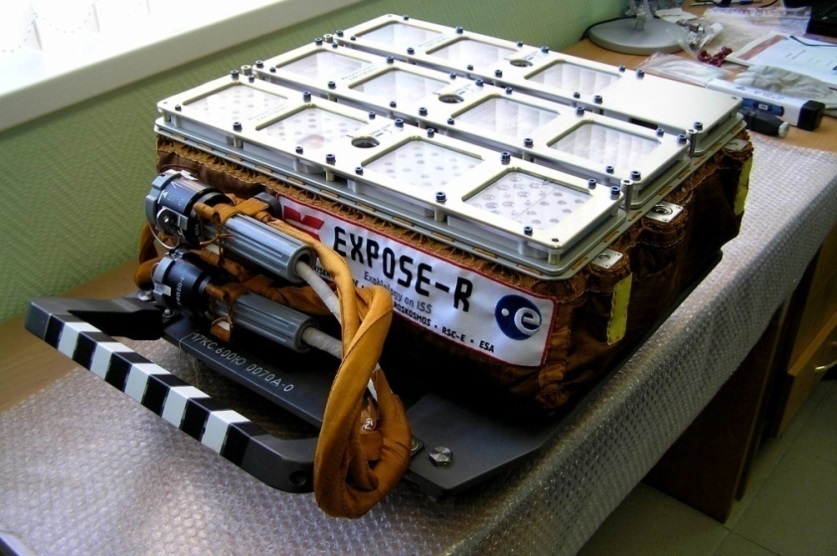
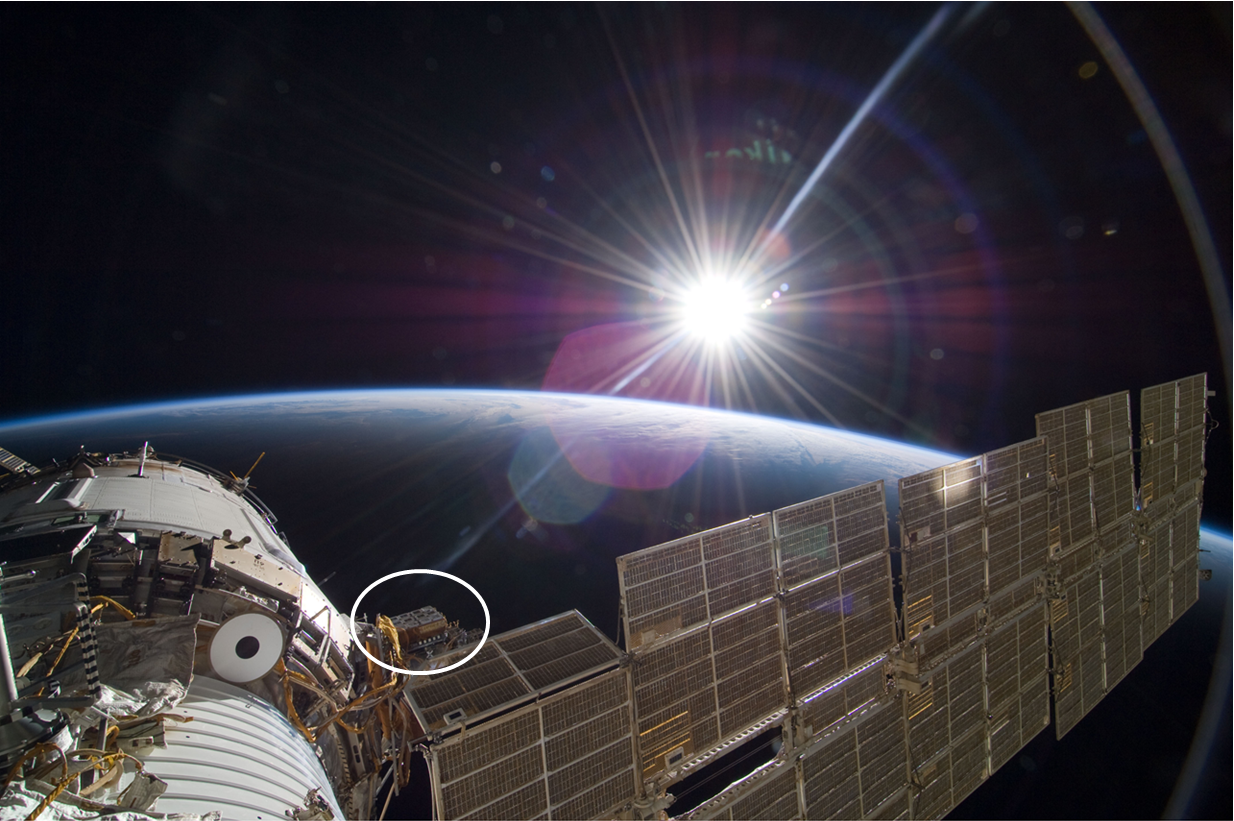
Figure 1 : En haut, EXPOSE avant son départ ; en bas, EXPOSE sur l'ISS (International Space Station)
The EXPOSE platform houses hundreds of samples of various kinds. In the case of the PSS experiment, they are arranged at a rate of 25 cells per sample holder. The cells are arranged to optimize space. To prevent leakage, which would distort all experiments by modifying the cell contents independently of the phenomenon observed, cells and sample holders are sealed with joints and screws (Figure 2), but are also brazed (welded). These preventive measures require lengthy preparation of the installation, as well as careful opening at the end of the experiment.
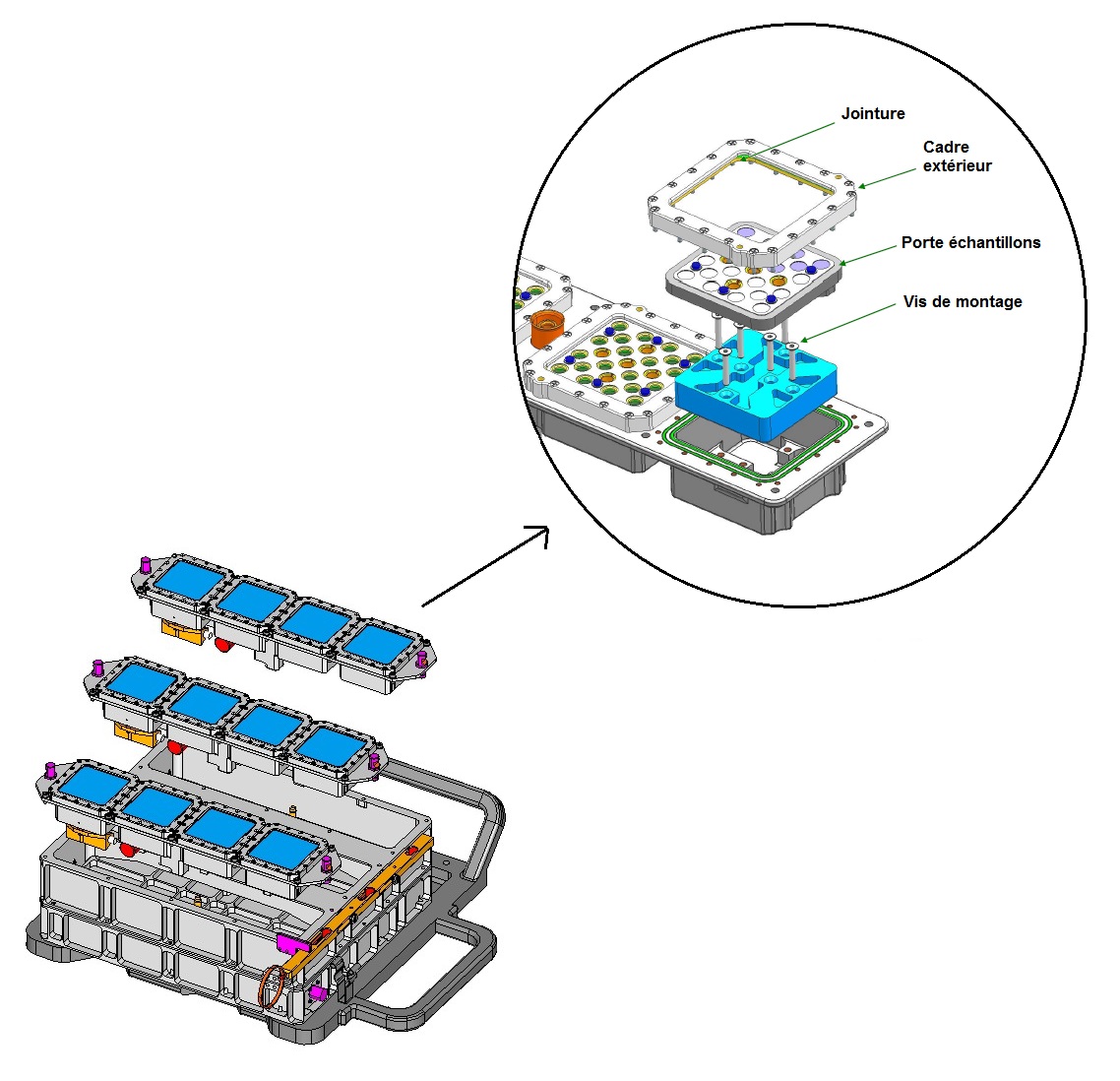
Figure 2 : une plateforme EXPOSE. Les portes échantillons ont des côtés de 86mm
On a sample holder, there are two layers of cells: the top layer, containing exposed cells, and the bottom layer, containing unexposed cells (Figure 3). Both sets of samples are identical, but the unexposed cells will serve as in-flight control samples: they will undergo the same temperature fluctuations as the exposed cells, but will not be affected by space radiation. Similarly, other control samples are kept in the laboratory, under different temperature and radiation conditions.
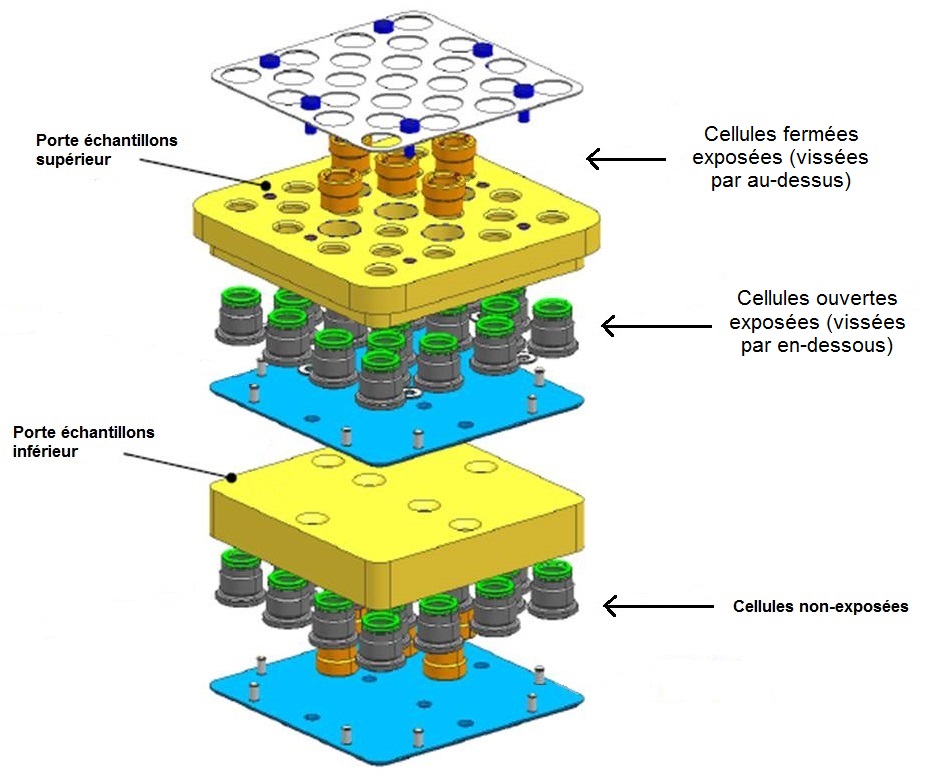
Figure 3 : organisation d'un porte échantillon pour les expériences du LISA, avec une couche de cellules exposées, et une couche de cellules non exposées. Les cellules font 9mm de diamètre, pour 12mm de profondeur
During their stay in orbit, the cells are not continuously exposed to solar radiation, due to the orientation of the space station. To be able to interpret the results accurately, we need to know the actual exposure time. To this end, EXPOSE is fitted with sensors to measure this time. Temperature is also measured.
These experiments exposing molecules to solar UV are the first long-term experiments (1 to 2 years) to be carried out in space. PROCESS samples returned to Earth in September 2009, AMINO samples in March 2011, and PSS samples in March 2016.
BIOPAN Platform
BIOPAN is an exposition device from ESA composed of two trays, where one is a lid to deployment. BIOPAN is set outside an automatic Russian satellite. It is closed during the launch and return operations.
|
|
|
| BIOPAN" module before launch, on board with the UVolution experience, coordinated by LISA | Diagram of the UVolution sample. It has two layers: one with exposed cells and other cells not exposed for control |
For UVolution, thanks to a dual-layer configuration, 60 flight samples are directly exposed to the solar flux while 60 others are not exposed and are used as samples of control in flight.
The FOTON capsule was launched by a Soyuz rocket on September 14, 2007, the duration of the flight was 12 days. 120 UVolution samples have therefore stayed for 12 days (09/14/2007-09/26/2007) at an altitude of approximately 300 km on the low-Earth orbit.
 |
|
| Launch of the Soyuz rocket | Return of FOTON on Earth, we see the BIOPAN module set outside |
During these 12 days of flying in low-Earth orbit, samples are not always facing the Sun; in fact the FOTON capsule revolves around the Earth by rotations on itself. What makes the total flux of solar UV received during the experience well below the residence time in space. It is rated at 29 (+/-4.35) SCH (constant solar time) in normal incidence. During the experiment temperature ranges from-22 ° C and 30 ° C. These data are recorded on board every 10 minutes.
 |
Recording of the temperature (° C) during the UVolution experiment. Temperatures range from-22 ° C and 30 ° C during the experiment. A rapid drop in temperature is recorded just after take-off (51 p.m.), on the other hand, a sudden increase in temperature on reentry into Earth's atmosphere (about 336 h).
Study of photochemistry in Earth orbit
|
Study of photochemistry in Earth orbit LISA is responsible for several photochemistry experiments of molecules of exobiologic and planetologicinterest, spatialized in low Earth orbit. Their objective is to better understand the nature and the evolution of organic matter and biomarkers present in extraterrestrial environments (including comets, Mars and Titan), when exposed to solar radiation. These experiments are held on different platforms of exhibition, under the responsibility of the ESA, for which it was necessary to develop open or closed cells exhibits. |
||
|
|
|
|
|
|
|
|
These systems are or have been implemented for the following projects :
- UV-olution: 14-26 September 2007
- PROCESS - exposes-E: February 2008 - August 2009
- AMINO - exposes-R: March 2009 - March 2011
Recently, a fourth PPS experiment (Photochemistry on the Space Station) has been selected by ESA for early 2012 to be exposed.
The first three experiments are a collaboration between LISA, LATMOS, the center of molecular biophysics of Orleans (CBM), ANBioPhy, with the support of CNES. The PSS experiment is a partnership between LISA, LATMOS, CBM, the Observatory of Bordeaux, the Institute ofbiomoleculeMax Mousseron (IBMM), and NASA AMES, always with the support of CNES. The PI (Principal Investigator) of these projects is Hervé COTTIN (LISA).
Cells Exhibit
Experiments of samples of molecules of exobiologic and planetologicinterest require designing cells exhibit. The samples we study are prepared in so-called "opened" or "closed” cells. Open cells are a legacy of exposure experiments that took place in Earth orbit in the 1990s and early 2000s. Closed cells have been developed to specifically meet the needs of our experiments concerning gaseous phase analysis and simulations of atmosphere. They were the subject of a phase of development in partnership with COMAT Aerospace (Toulouse), and then a phase of optimization with the Advanced Techniques Division of Air Liquide company. This original development has been funded by CNES.
OPEN CELLS
Two types of open cells were used for experiments in Earth orbit. The molecules are deposited on the inside of the cell window. According to the type of atmosphere to simulate, windows are either MgF2 or quartz. MgF2 is a material which has a good transmission in the far UV field (transparent to UV > 110nm), which allows to have a photolysis including the Lyman band (122 nm), very intense in the VUV solar field. Quartz cuts UV radiation below 190 nm, which simulates the Martian environment where the atmosphere filters the UV < 190 nm. With open cells, we can conduct studies on kinetics of photochemical reactions. However, the volatile products of photo-destruction are evacuated by ventilation systems to the space vacuum and are therefore non-analyzable.
 |
An open cell composed of a cylindrical aluminum rim and a window MgF2 or quartz on the cylinder. The organic molecule is deposited on the inside of the window. Such cells have been used to UVolution and PROCESS. (Figure of COMAT, France).
 |
Design of an open cell such as those used in AMINO (schema: Kayser - Threde GmbH Germany)
CLOSED CELLS
During the three Uvolution, PROCESS and AMINO experiments, closed cells were first used for the first timein orbit exhibition experiments. They can be used to study the photolysis of a gas mixture (simulation of an atmosphere) or photolysis of a solid molecule by interaction with a simulated atmosphere (for example, a molecule on the surface of Mars), or even analyze gaseous products from the photo-dissociation of an organic solid molecule.
If the concept has not changed, the manufacturing process has significantly changed since their first use in UVolution and PROCESS in 2007. The first generation of closed cells consisted of two cylinders of aluminum (a male part and a female part) that screw into each other. A window (MgF2 or quartz) is pasted at each end of the cell. The tightness is ensured by an o-ring Viton between the two parties (design of cells: COMAT, Toulouse, France). It has been demonstrated that the leak level is sufficient to not disrupt short-term experiments as UVolution (14 days in space, and about a month between the sample preparation and analysis after the return), but insufficient to ensure more long-term PROCESS or AMINO experiments. Therefore, it is possible that closed cells mounted on the PROCESS experiment are almost empty when they are back on Earth.
A new generation of closed cells was manufactured for the AMINO experience, by Air Liquide (Grenoble, France). This time, the cell body is made of stainless steel, windows are brazed, and the sealed between the two parts of the cells is ensured by a laser welding. The results of leak tests (< 10-10 atm. L.s-1) show that this new design is consistent with the experiments of long duration in orbit (loss < 10% for 2 years in space).
|
|
Design of a closed cell. For the first generation of closed cells, two cylinders in aluminum are screwed into each other. Two MgF2 or quartz windows are glued to both ends, which allow the analysis of the samples within the cell by spectroscopy. The tightness is ensured by a Viton o-ring. For the new generation of closed cells, the body is stainless steel, windows are brazed and tightness is ensured by laser welding. (Schema: COMAT)
Gaseous samples are prepared in a specially developed analytical cell for these projects. This analytical cell is designed for both the fill and the reopening of closed cells. It consists mainly of two parts in stainless steel, in which the two parties (male and female) of a closed cell are mounted separately. The two parts of the analytical cell are then adjusted and sealed with a Viton o-ring. The gas mixture of the experiment may then be introduced into the analytical cell, then the two parts of the closed cell can be screwed one into each other, by means of a screw connecting the interior cell of analysis. Thus, the gas is trapped inside the closed cell.
 |
Design of the analytical cell. It allows the filling of gas in a closed cell, and analysis at the end of the experiments. An integrated infrared chamber can be used for the analysis of the gas after opening of a closed cell. (Schema COMAT).
COSIMA
COSIMA (COmetary Secondary Ion MAss spectrometer) est l’un des instruments de la sonde spatiale européenne ROSETTA qui a suivi et exploré la comète 67P/Churyomov-Gerasimenko entre début août 2014 et fin septembre 2016. Il s’agit un spectromètre de masse d’ions secondaire à temps de vol (TOF-SIMS) dont l’objectif était l’analyse de la composition chimique des particules cométaires collectées dans l’atmosphère de la comète. Le LISA a collaboré depuis le début des années 2000 de façon étroite avec le LPC2E d’Orléans (qui dispose d’un spectromètre de masse dont les caractéristiques sont voisines de celles de l’instrument de vol), et le MPS de Goettingen (laboratoire du PI de COSIMA où se trouve un modèle sol de l’instrument identique à celui embarqué sur ROSETTA) afin de réaliser des spectres de calibrations concernant la matière organique telle qu’elle pourrait être mesurée avec COSIMA. Lors de la phase d’exploration de la comète nous avons été très fortement impliqués dans les opérations d’analyse de l’instrument et dans l’exploitation des résultats. Nous avons contribué à l’interprétation des spectres de masses et nous nous sommes prioritairement intéressés à la caractérisation de la matière organique contenue dans les particules cométaires collectées.
Actuellement, en Juin 2024, nous continuons encore à décrypter la composition cométaire à l’aide des données qui restent encore en grande partie sous-exploitées. Nous avons pu détecter la présence d’une composante organique de haut poids moléculaire qui représente environ 50% de la masse de des particules de la comète, dont nous avons caractérisé sa composition (rapports N/C, H/C…). Nous cherchons aussi à mesurer la diversité de composition des particules les unes par rapport aux autres afin de construire un scénario cohérent concernant leur formation et leurs potentiels héritages interstellaires et/ou protoplanétaires.
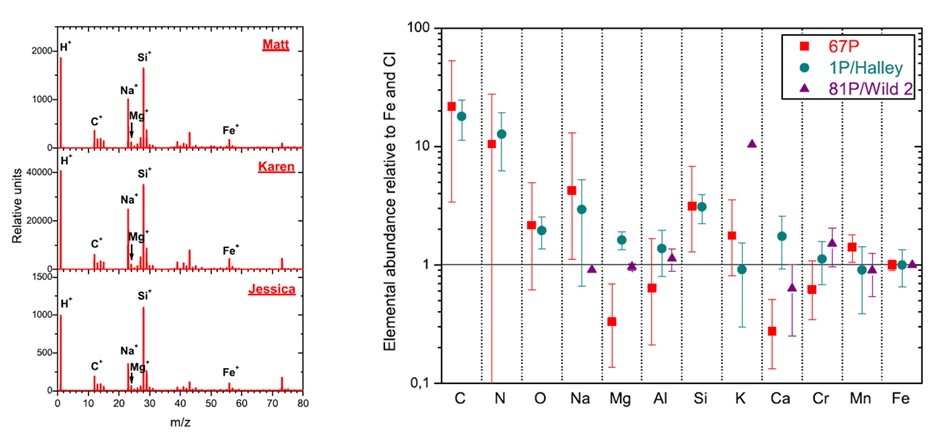
A gauche : spectres de masses mesurés sur trois particules collectées et analysées par COSIMA. A droite composition élémentaire moyenne des particules de la comète 67P, comparée à celles des comètes 1P/Halley et 81P/Wild 2. Ces compositions sont doublement normalisées au fer et à l’abondance des éléments dans les chondrites carbonées de type CI. L’abondance de carbone et de matière organique est environ 10 fois supérieure dans les particules de la comète 67P que dans les chondrites. Figures extraites de Bardyn et al 2017.
Pour en savoir plus : https://www.mps.mpg.de/en/rosetta/cosima
Principales publications du LISA à ce sujet :
- Bardyn, A., Baklouti, D., Cottin, H., Fray, N., Briois, C., Paquette, J., Stenzel, O., Engrand, C., Fischer, H., Hornung, K., Isnard, R., Langevin, Y., Lehto, H., Le Roy, L., Ligier, N., Merouane, S., Modica, P., Orthous-Daunay, F.-R., Rynö, J., Schulz, R., Silén, J., Thirkell, L., Varmuza, K., Zaprudin, B., Kissel, J. and Hilchenbach, M. (2017) Carbon-rich dust in comet 67P/Churyumov-Gerasimenko measured by COSIMA/Rosetta. Month. Not. Roy. Astr. Soc. 469, S712-S722.
- Fray, N., Bardyn, A., Cottin, H., Baklouti, D., Briois, C., Engrand, C., Fischer, H., Hornung, K., Isnard, R., Langevin, Y., Lehto, H., Le Roy, L., Mellado, E.M., Merouane, S., Modica, P., Orthous-Daunay, F.-R., Paquette, J., Rynö, J., Schulz, R., Silén, J., Siljeström, S., Stenzel, O., Thirkell, L., Varmuza, K., Zaprudin, B., Kissel, J. and Hilchenbach, M. (2017) Nitrogen-to-carbon atomic ratio measured by COSIMA in the particles of comet 67P/Churyumov–Gerasimenko. Month. Not. Roy. Astr. Soc. 469, S506-S516.
- Isnard, R., Bardyn, A., Fray, N., Briois, C., Cottin, H., Paquette, J., Stenzel, O., Alexander, C., Baklouti, D., Engrand, C., Orthous-Daunay, F.-R., Siljeström, S., Varmuza, K. and Hilchenbach, M. (2019) H/C elemental ratio of the refractory organic matter in cometary particles of 67P/Churyumov-Gerasimenko. Astron. Astophys. 630, A27.
- Sansberro, I., Fray, N., Cottin, H., Baklouti, D., Bardyn, A., Briois, C., Engrand, C., Paquette, J., Silén, J., Stenzel, O.J. and Hilchenbach, M. (2022) Variability in the elemental composition of the dust particles of 67P/Churyumov-Gerasimenko, 44th COSPAR Scientific Assembly.






